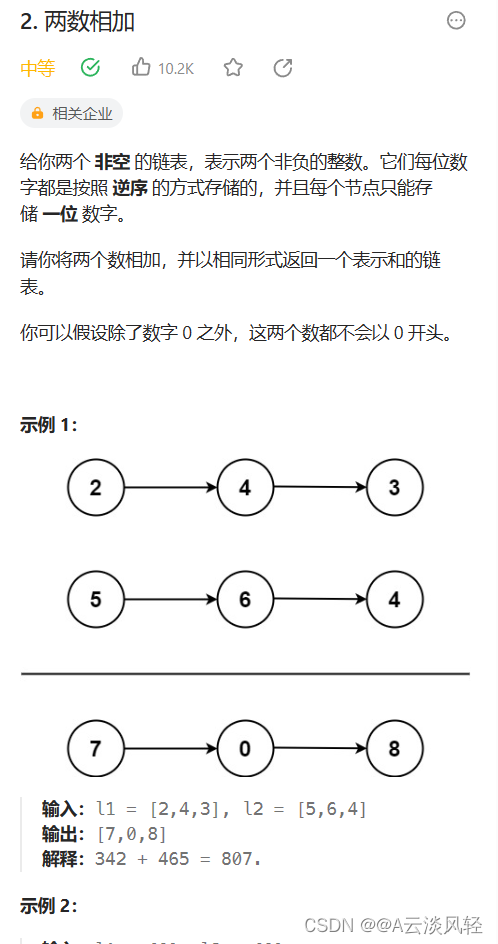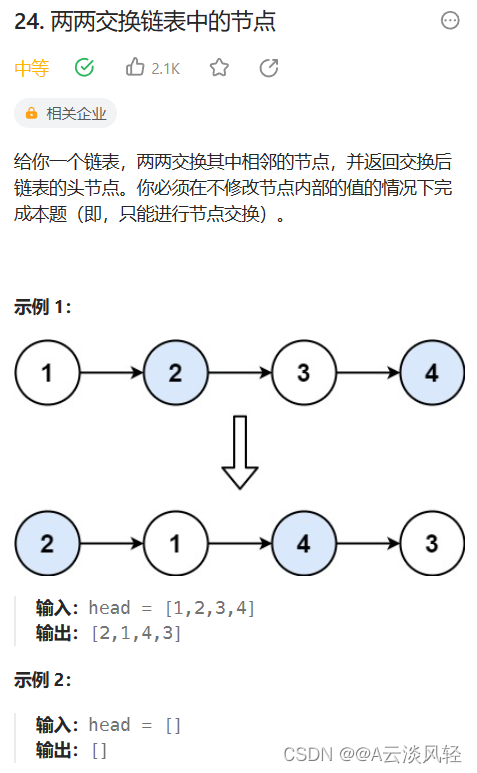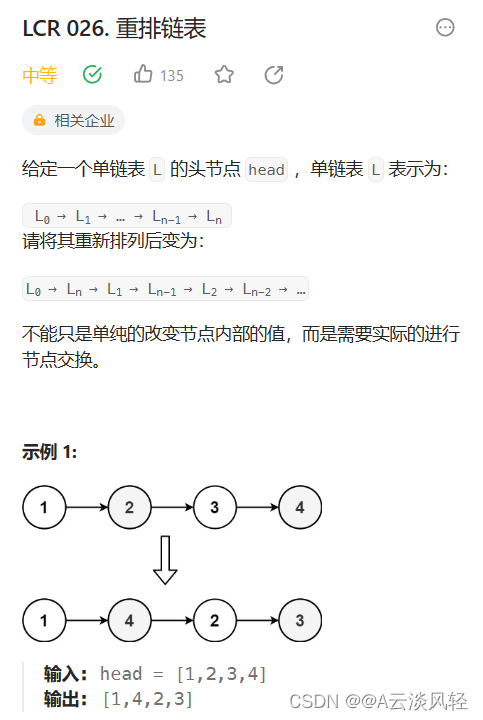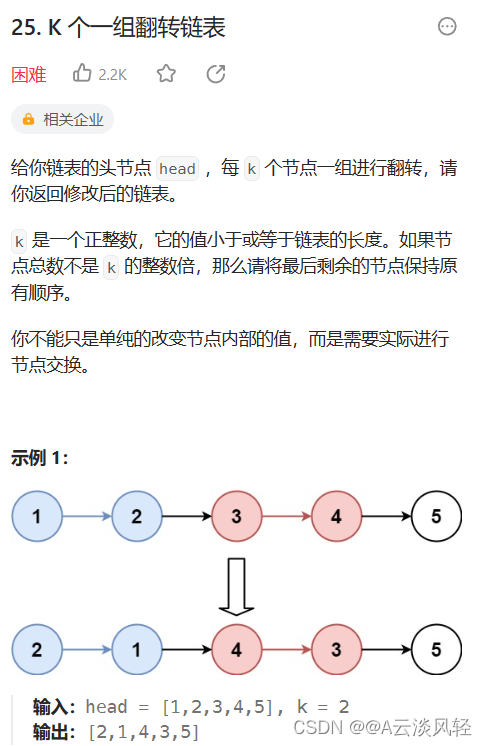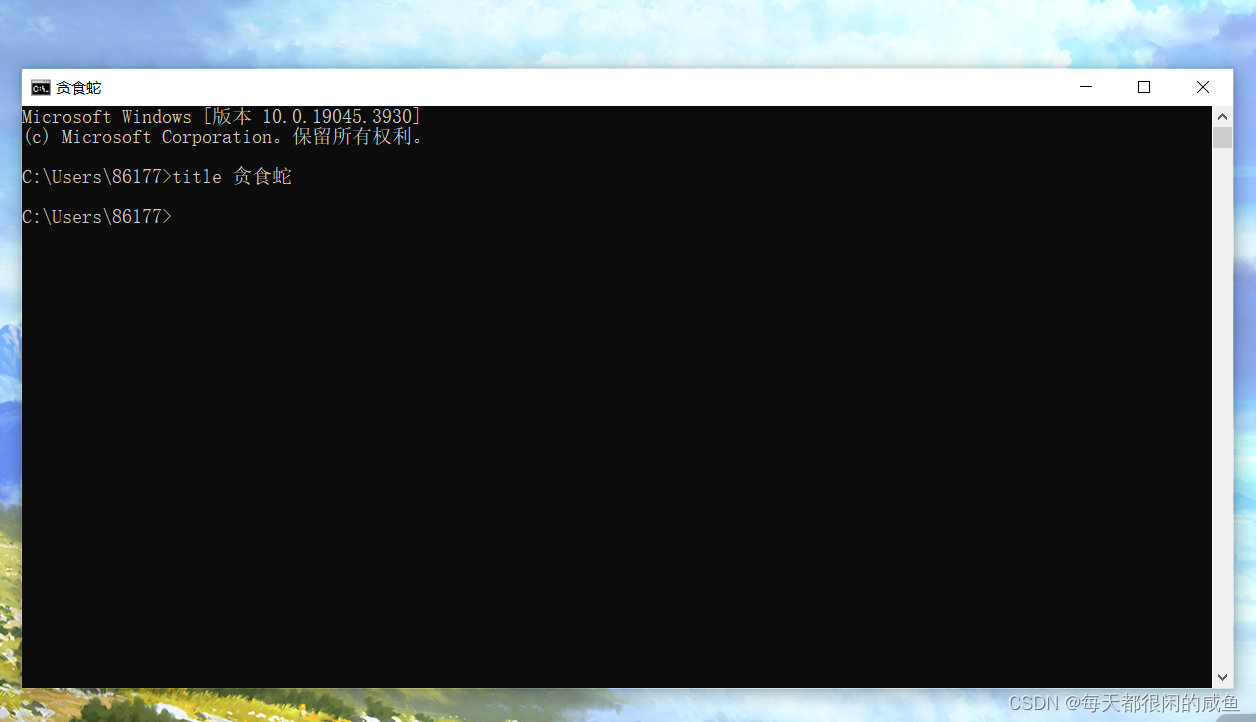1.两数相加
/**
* Definition for singly-linked list.
* struct ListNode {
* int val;
* ListNode *next;
* ListNode() : val(0), next(nullptr) {}
* ListNode(int x) : val(x), next(nullptr) {}
* ListNode(int x, ListNode *next) : val(x), next(next) {}
* };
*/
class Solution {
public:
ListNode* addTwoNumbers(ListNode* l1, ListNode* l2) {
ListNode* newhead = new ListNode(0);
ListNode* prev = newhead;
int t = 0;
ListNode* cur1 = l1,*cur2 = l2;
while(cur1 || cur2 || t)
{
if(cur1)
{
t += cur1->val;
cur1 = cur1->next;
}
if(cur2)
{
t += cur2->val;
cur2 = cur2->next;
}
prev->next = new ListNode(t%10);
prev = prev->next;
t /= 10;
}
prev = newhead->next;
delete newhead;
return prev;
}
};
2.两两交换链表中的节点
/**
* Definition for singly-linked list.
* struct ListNode {
* int val;
* ListNode *next;
* ListNode() : val(0), next(nullptr) {}
* ListNode(int x) : val(x), next(nullptr) {}
* ListNode(int x, ListNode *next) : val(x), next(next) {}
* };
*/
class Solution {
public:
//模拟 循环 迭代
ListNode* swapPairs(ListNode* head) {
if(head == nullptr || head->next == nullptr) return head;
ListNode* ret = new ListNode(0);
ListNode* prev = ret;
prev->next = head;
ListNode* cur = prev->next,*next = cur->next,*nnext = next->next;
while(cur && next)
{
//交换节点
prev->next = next;
next->next = cur;
cur->next = nnext;
//更新节点
prev = cur;
cur = nnext;
if(cur) next = cur->next;
if(next) nnext = next->next;
}
cur = ret->next;
delete ret;
return cur;
}
};
3.重排链表
/**
* Definition for singly-linked list.
* struct ListNode {
* int val;
* ListNode *next;
* ListNode() : val(0), next(nullptr) {}
* ListNode(int x) : val(x), next(nullptr) {}
* ListNode(int x, ListNode *next) : val(x), next(next) {}
* };
*/
class Solution {
public:
void reorderList(ListNode* head) {
if(head == nullptr || head->next == nullptr || head->next->next == nullptr) return;
ListNode* ret = new ListNode(0);
ListNode* prev = ret;
//1.找中间节点
ListNode* slow = head,*fast = head;
while(fast && fast->next)
{
slow = slow->next;
fast = fast->next->next;
}
//2.将slow后面的链表部分逆序
ListNode* newhead = new ListNode(0);
ListNode* cur = slow->next;
slow->next = nullptr;//将前一段链表和后一段链表断开
while(cur)
{
ListNode* next = cur->next;
cur->next = newhead->next;
newhead->next = cur;
cur = next;
}
//3.合并两个链表
ListNode* cur1 = head,*cur2 = newhead->next;
while(cur1 || cur2)
{
if(cur1)
{
prev->next = cur1;
cur1 = cur1->next;
prev = prev->next;
}
if(cur2)
{
prev->next = cur2;
cur2 = cur2->next;
prev = prev->next;
}
}
delete ret;
delete newhead;
}
};
4.合并K个升序链表
/**
* Definition for singly-linked list.
* struct ListNode {
* int val;
* ListNode *next;
* ListNode() : val(0), next(nullptr) {}
* ListNode(int x) : val(x), next(nullptr) {}
* ListNode(int x, ListNode *next) : val(x), next(next) {}
* };
*/
class Solution {//法一:
struct cmp
{
bool operator()(const ListNode* l1,const ListNode* l2)
{
return l1->val>l2->val;
}
};
public:
ListNode* mergeKLists(vector<ListNode*>& lists) {
if(lists.size() == 0) return nullptr;
if(lists.size() == 1) return lists[0];
//使用优先级队列,即最小堆来解决
priority_queue<ListNode*,vector<ListNode*>,cmp> heap;
ListNode* ret = new ListNode(0);
ListNode* prev = ret;
for(auto l:lists)
{
if(l) heap.push(l);
}
while(!heap.empty())
{
ListNode* t = heap.top();
heap.pop();
prev->next = t;
prev = t;
if(t->next) heap.push(t->next);
}
prev = ret->next;
delete ret;
return prev;
}
};
/**
* Definition for singly-linked list.
* struct ListNode {
* int val;
* ListNode *next;
* ListNode() : val(0), next(nullptr) {}
* ListNode(int x) : val(x), next(nullptr) {}
* ListNode(int x, ListNode *next) : val(x), next(next) {}
* };
*/
class Solution {//法二:使用归并-递归来解决
public:
ListNode* mergeKLists(vector<ListNode*>& lists) {
return merge(lists,0,lists.size()-1);
}
ListNode* merge(vector<ListNode*>& lists,int left,int right)
{
if(left > right) return nullptr;
if(left == right) return lists[left];
//1.选择中间元素划分区间
int mid = (left+right)>>1;
//[left,mid][mid+1,right]
//2.处理左右区间
ListNode* l1 = merge(lists,left,mid);
ListNode* l2 = merge(lists,mid+1,right);
//3.合并两个有序链表
ListNode* ret = new ListNode(0);
ListNode* prev = ret;
ListNode* cur1 = l1,*cur2 = l2;
while(cur1 && cur2)
{
if(cur1->val <= cur2->val)
{
prev->next = cur1;
prev = prev->next;
cur1 = cur1->next;
}
else
{
prev->next = cur2;
prev = prev->next;
cur2 = cur2->next;
}
}
if(cur1) prev->next = cur1;
if(cur2) prev->next = cur2;
prev = ret->next;
delete ret;
return prev;
}
};
5.K个一组翻转链表
/**
* Definition for singly-linked list.
* struct ListNode {
* int val;
* ListNode *next;
* ListNode() : val(0), next(nullptr) {}
* ListNode(int x) : val(x), next(nullptr) {}
* ListNode(int x, ListNode *next) : val(x), next(next) {}
* };
*/
class Solution {
public:
ListNode* reverseKGroup(ListNode* head, int k) {
//模拟
if(head==nullptr || head->next==nullptr) return head;
//1.计算需要翻转的组数n
int n = 0;
ListNode* cur = head;
while(cur)
{
n++;
cur = cur->next;
}
n /= k;
cur = head;
//2.重复n次,长度为n的链表逆序
ListNode* ret = new ListNode(0);
ListNode* prev = ret;
for(int i = 0;i<n;i++)
{
ListNode* tmp = cur;
for(int j = 0;j<k;j++)
{
ListNode* next = cur->next;
cur->next = prev->next;
prev->next = cur;
cur = next;
}
prev = tmp;
}
prev->next = cur;
prev = ret->next;
delete ret;
return prev;
}
};
原文地址:https://blog.csdn.net/m0_55283616/article/details/134622703
本文来自互联网用户投稿,该文观点仅代表作者本人,不代表本站立场。本站仅提供信息存储空间服务,不拥有所有权,不承担相关法律责任。
如若转载,请注明出处:http://www.7code.cn/show_14481.html
如若内容造成侵权/违法违规/事实不符,请联系代码007邮箱:suwngjj01@126.com进行投诉反馈,一经查实,立即删除!
主题授权提示:请在后台主题设置-主题授权-激活主题的正版授权,授权购买:RiTheme官网
声明:本站所有文章,如无特殊说明或标注,均为本站原创发布。任何个人或组织,在未征得本站同意时,禁止复制、盗用、采集、发布本站内容到任何网站、书籍等各类媒体平台。如若本站内容侵犯了原著者的合法权益,可联系我们进行处理。

